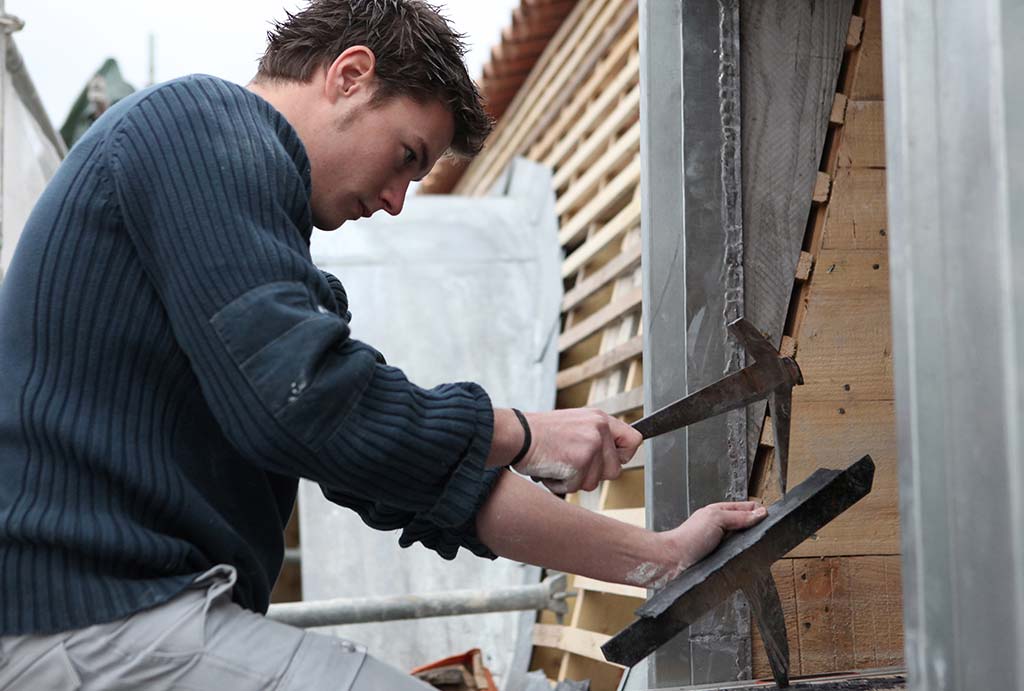Slate roofing is one of the longest-lasting and highest quality roofing materials available. It has been used for centuries on things like castles and churches since it was the choice material at the time. Today, slate is still the primary choice for high values roofs and those looking for the best. Despite all the modern roofing materials, slate has still maintained its position as the gold standard.
However, slate roofs do have a wide assortment of pros and cons. When deciding to have a slate roof installed it is advisable to know as much about these as possible. Without further ado, here is the complete guide to slate roofing.
Slate Roof Benefits
Slate roofs have a vast array of benefits. These include safety, insulation value, longevity, and beauty. This assortment of pros explains why such an old school material is still in use today, despite the abundance of modern roofing materials.
Safety
Slate is a non-conductive material, meaning that electricity cannot travel through it. Greatly diminishing the danger of electrical hazards. In addition, slate is completely fireproof with a stone being one of the few materials that do not burn. This makes slate ideal roofing material for anyone that is concerned about fire. With slate, there is no worry that a stray spark from a firework will set your house ablaze. Furthermore, if a neighbor’s house is in flames you can be confident a wandering ember will not ignite your home. Given enough heat, the slate could crack, however that would require your home being engulfed in flames to do so. All things considered slate has a high safety factor that any homeowner can rely on.
Insulation Value
Slate has excellent insulation properties. Since it is so hard and dense both hot and cold air have an extremely difficult time making it through. This, in turn, leads to a more comfortable home and a possible reduction in your energy bill. However, the size of the reduction will depend on your actions. If your energy habits are not efficient to begin with, installing a slate roof will not help any. Stones can still hold and conduct both hot and cold, so without proper insulation, some of that energy can pass through. Although they work very well when combined with an underlayment.
Longevity
This is where slate roofs truly shine. A properly installed slate roof can be expected to last as long as 50 to 100 years. It is no coincidence that all of the world’s oldest structures are made of stone. In addition, since stone is not manufactured there is no worry of manufacturing defects. This has led to many roofing companies guaranteeing their work for years to come. In fact, while many other roofing materials will require repairs or maintenance within a decade slate is relatively worry-free. That is a huge plus when other roofing systems are expected to last 20 or 30 years. Whereas 100 to 150 years or more is common for most slate roofs.
Slate also does a better job of handling the worst weather conditions when compared to other materials. Things like heavy rains, blizzards, and hail storms are nothing when it comes to slate. Slate roofing tiles have already tolerated the weather for thousands, if not millions of years because they are made of stone. They shrug off the worst weather conditions, protecting your home while maintaining their beauty.
Beauty
Finally, the primary reason homeowners are drawn to slate roofing is their inherent beauty. Modern roofing materials cannot match the look of natural stone. This is why slate has remained a superior roofing material. Many commercial shingles try to emulate the appearance of slate for this reason. However, nothing compares to the real thing, no matter how good fake stone looks. No other roofing material can compare to the texture and color natural stone brings to your home. Slate roofing will bring an element of beauty and charm to your home that is hard to get elsewhere. A variety of color options are available to match your home such as black, red, purple, and even green. In addition, slate can be dyed and is available in nearly any pattern or color that you desire.
Slate Roof Drawbacks
As with any roofing system slate does come with its share of disadvantages. These are why slate is not as common as it once was despite all the great advantages. These drawbacks include impact resistance, weight, installation problems, and cost.
Impact Resistance
While slate roofing does an excellent job of combating weather it does suffer in its resistance to impacts. Slate is very hard, but extremely inflexible leading to it being fairly brittle. The hardest materials are sometimes the easiest to break and the slate is susceptible to a sharp impact. Things like hailstones are not going to break your tiles as has been demonstrated in studies. However, anything harder than a hailstone does have the chance of shattering tiles. Walking on slate roofs can also be extremely damaging. Even the most careful roofer could accidentally break tiles by stepping on them the wrong way. Compounding this issue is that each slate tile has a different shape and size. This is due to it being a natural material and the grain is seldom 100% straight. Meaning it can be extremely difficult and expensive to replace tiles if needed.
Weight
Another common issue with slate roofing is the massive weight of them. If your house is not structurally sound and strong, then slate can be awful roofing material. Most homes need to be well reinforced to handle the extra weight of a stone roof. This is probably one of the main reasons it is used less today than in the past.
Installation Problems
Installation problems are another serious concern when talking about slate roofs. Since they are not as common these days it is hard to find contractors who have experience with them. Furthermore, if you do find a good roofing specialist with the experience you can expect to pay much more. Those companies that do work on slate roofs do not have the opportunities to use those skills often. For this reason, they will often charge much more than standard roof repairs.
When looking for a contractor to install a slate roof on your home be sure to ask to see some of their previous work and references. It is best practice to make sure the roofing company has performed at the very least, two slate roof jobs in the past. Some companies will not be honest about their past experience with slate. Therefore, it is best to walk away from a company that does not include slate roofing jobs in their portfolio.
Cost
All of these issues lead to a much higher cost than more modern roofing systems. A slate roof can be significantly more expensive than some of the other options. Not only in the installation, but maintenance costs can be much higher. Slate tile roofing can cost anywhere from $6,000 to $8,000 per 100 square feet. However, some estimates are a bit more conservative at $1,000 to $4,000 per 100 square feet. This can be five times more than conventional materials and leads to a huge initial investment.
Conclusions
Slate roofing systems have many advantages and disadvantages as you can see. When considering a slate roof it is best to assess your needs and your budget to see if a slate roof is the best fit for you. If you have any questions about slate roofing feel free to give us a call. We love to hear from our customers and help guide them to the best fit. Call today to speak with an expert and get your quote!

